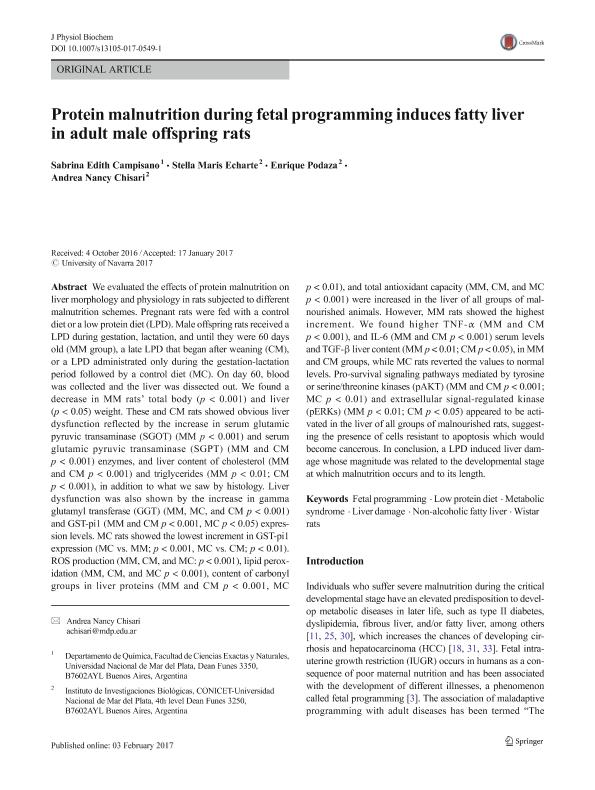Mostrar el registro sencillo del ítem
dc.contributor.author
Campisano, Sabrina Edith

dc.contributor.author
Echarte, Stella Maris

dc.contributor.author
Podaza, Enrique Arturo

dc.contributor.author
Chisari, Andrea Nancy

dc.date.available
2018-01-24T15:19:42Z
dc.date.issued
2017-05
dc.identifier.citation
Campisano, Sabrina Edith; Echarte, Stella Maris; Podaza, Enrique Arturo; Chisari, Andrea Nancy; Protein malnutrition during fetal programming induces fatty liver in adult male offspring rats; Servicio Publicaciones Universidad Navarra; Journal Of Physiology And Biochemistry; 73; 2; 5-2017; 275-285
dc.identifier.issn
1138-7548
dc.identifier.uri
http://hdl.handle.net/11336/34392
dc.description.abstract
We evaluated the effects of protein malnutrition on liver morphology and physiology in rats subjected to different malnutrition schemes. Pregnant rats were fed with a control diet or a low protein diet (LPD). Male offspring rats received a LPD during gestation, lactation, and until they were 60 days old (MM group), a late LPD that began after weaning (CM), or a LPD administrated only during the gestation-lactation period followed by a control diet (MC). On day 60, blood was collected and the liver was dissected out. We found a decrease in MM rats’ total body (p < 0.001) and liver (p < 0.05) weight. These and CM rats showed obvious liver dysfunction reflected by the increase in serum glutamic pyruvic transaminase (SGOT) (MM p < 0.001) and serum glutamic pyruvic transaminase (SGPT) (MM and CM p < 0.001) enzymes, and liver content of cholesterol (MM and CM p < 0.001) and triglycerides (MM p < 0.01; CM p < 0.001), in addition to what we saw by histology. Liver dysfunction was also shown by the increase in gamma glutamyl transferase (GGT) (MM, MC, and CM p < 0.001) and GST-pi1 (MM and CM p < 0.001, MC p < 0.05) expression levels. MC rats showed the lowest increment in GST-pi1 expression (MC vs. MM; p < 0.001, MC vs. CM; p < 0.01). ROS production (MM, CM, and MC: p < 0.001), lipid peroxidation (MM, CM, and MC p < 0.001), content of carbonyl groups in liver proteins (MM and CM p < 0.001, MC p < 0.01), and total antioxidant capacity (MM, CM, and MC p < 0.001) were increased in the liver of all groups of malnourished animals. However, MM rats showed the highest increment. We found higher TNF-α (MM and CM p < 0.001), and IL-6 (MM and CM p < 0.001) serum levels and TGF-β liver content (MM p < 0.01; CM p < 0.05), in MM and CM groups, while MC rats reverted the values to normal levels. Pro-survival signaling pathways mediated by tyrosine or serine/threonine kinases (pAKT) (MM and CM p < 0.001; MC p < 0.01) and extrasellular signal-regulated kinase (pERKs) (MM p < 0.01; CM p < 0.05) appeared to be activated in the liver of all groups of malnourished rats, suggesting the presence of cells resistant to apoptosis which would become cancerous. In conclusion, a LPD induced liver damage whose magnitude was related to the developmental stage at which malnutrition occurs and to its length.
dc.format
application/pdf
dc.language.iso
eng
dc.publisher
Servicio Publicaciones Universidad Navarra

dc.rights
info:eu-repo/semantics/openAccess
dc.rights.uri
https://creativecommons.org/licenses/by-nc-sa/2.5/ar/
dc.subject
Fetal Programming
dc.subject
Liver Damage
dc.subject
Low Protein Diet
dc.subject
Metabolic Syndrome
dc.subject
Non-Alcoholic Fatty Liver
dc.subject
Wistar Rats
dc.subject.classification
Otras Ciencias Biológicas

dc.subject.classification
Ciencias Biológicas

dc.subject.classification
CIENCIAS NATURALES Y EXACTAS

dc.title
Protein malnutrition during fetal programming induces fatty liver in adult male offspring rats
dc.type
info:eu-repo/semantics/article
dc.type
info:ar-repo/semantics/artículo
dc.type
info:eu-repo/semantics/publishedVersion
dc.date.updated
2017-12-12T19:56:34Z
dc.journal.volume
73
dc.journal.number
2
dc.journal.pagination
275-285
dc.journal.pais
España

dc.journal.ciudad
Pamplona
dc.description.fil
Fil: Campisano, Sabrina Edith. Universidad Nacional de Mar del Plata. Facultad de Ciencias Exactas y Naturales. Departamento de Química; Argentina
dc.description.fil
Fil: Echarte, Stella Maris. Consejo Nacional de Investigaciones Científicas y Técnicas. Centro Científico Tecnológico Conicet - Mar del Plata. Instituto de Investigaciones Biológicas. Universidad Nacional de Mar del Plata. Facultad de Ciencias Exactas y Naturales. Instituto de Investigaciones Biológicas; Argentina
dc.description.fil
Fil: Podaza, Enrique Arturo. Consejo Nacional de Investigaciones Científicas y Técnicas. Centro Científico Tecnológico Conicet - Mar del Plata. Instituto de Investigaciones Biológicas. Universidad Nacional de Mar del Plata. Facultad de Ciencias Exactas y Naturales. Instituto de Investigaciones Biológicas; Argentina
dc.description.fil
Fil: Chisari, Andrea Nancy. Consejo Nacional de Investigaciones Científicas y Técnicas. Centro Científico Tecnológico Conicet - Mar del Plata. Instituto de Investigaciones Biológicas. Universidad Nacional de Mar del Plata. Facultad de Ciencias Exactas y Naturales. Instituto de Investigaciones Biológicas; Argentina
dc.journal.title
Journal Of Physiology And Biochemistry

dc.relation.alternativeid
info:eu-repo/semantics/altIdentifier/url/http://link.springer.com/article/10.1007/s13105-017-0549-1
dc.relation.alternativeid
info:eu-repo/semantics/altIdentifier/url/https://link.springer.com/article/10.1007/s13105-017-0549-1
Archivos asociados
